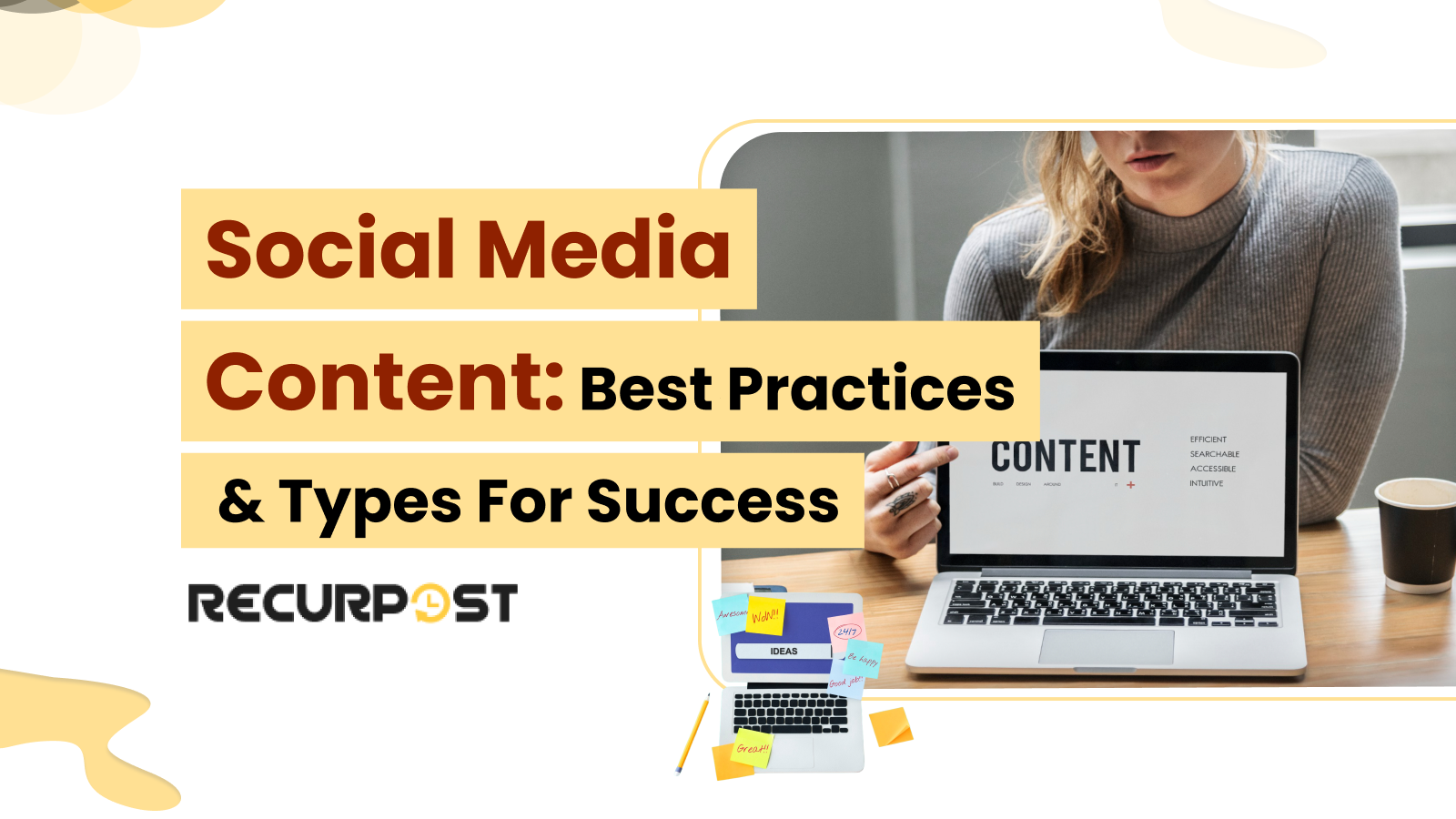Social media content shapes how brands communicate, how voices grow, and how communities form around shared ideas.
Not all content performs the same. Text-based content, visual content, and video content can spark major engagement, while other posts barely register.
Knowing what type of social media content to publish, which platforms to prioritize, and how to stay relevant can turn a standard feed into one that draws consistent attention.
This guide provides social media content examples that show what works, what falls flat, and how different content types keep audiences engaged over time.
Understanding Social Media Strategy & Content
Social media content goes far beyond posting photos or dropping links. It shapes how audiences connect, interact, and build lasting relationships with brands. The way content creation and content distribution are handled across social media platforms plays a direct role in long-term brand success.
Each part of social media content planning shows why certain posts resonate and others fade away.
What is Social Media Content Creation

Social media content creation means planning, designing, and producing tailored posts for Instagram, Facebook, LinkedIn, TikTok, and other channels. This includes text-based content such as blog snippets and tweets, visual content like infographics, and video content ranging from short clips to longer formats.
What is Social Media Content
Social media content covers every format shared across platforms: text updates, photos, videos, infographics, memes, stories, reels, and polls. Strong social media content keeps audiences engaged, builds authenticity, and reflects brand goals.
Different social media platforms support varied content formats. The most common include:
Text-Based Content: Status updates, blog posts, captions, hashtags, and tweets convey quick ideas, share updates, and express opinions that encourage audience interaction.
Visual Content: Pictures, branded graphics, carousel posts, single-image posts, infographics, memes, and gifs capture attention faster than text and simplify complex ideas. Infographics also present data in clear, digestible formats.
Video Content: Short-form videos such as Instagram Reels, TikToks, and YouTube Shorts deliver fast messages that drive high engagement. Long-form videos like YouTube vlogs and Facebook Live sessions allow for storytelling, tutorials, and in-depth communication.
Interactive Content: Polls and surveys, quizzes, challenges, and interactive stickers encourage audience participation. Increased interaction strengthens audience connections with brands.
User-Generated Content (UGC): Content created by audiences, like customer photos, reviews, or posts featuring brands. UGC builds trust and authenticity by showing real people engaging with products or services.
AI Instagram Post Generator
Create stunning captions, hooks – done for you in seconds.
⭐ 4.3/5 average user rating (based on 2,000+ reviews)
What Are the Best Social Media Platforms
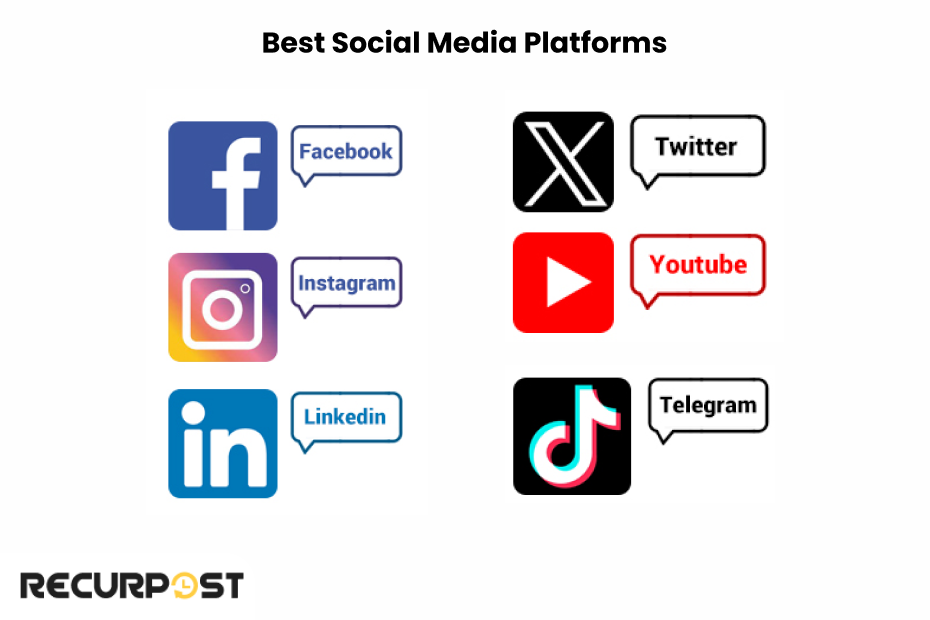
1. Instagram – Great for visually-driven content like stories, reels, carousel posts, and short videos. Ideal for fashion, beauty, food, skincare, travel, restaurant, and lifestyle brands.
2. Facebook – Perfect for building a community, sharing updates, and running ads. Facebook also offers a variety of content formats like posts, images, videos, live streams, and events.
3. Twitter/X – Ideal for real-time updates, conversations, and engagement with your audience. Tweets share news, opinions, and brand messages in concise formats.
4. LinkedIn – Tailored for professionals and B2B communication. LinkedIn articles, case studies, and industry insights perform well, especially in fields like real estate, finance, and consulting.
5. TikTok – If your brand targets a younger, trend-savvy audience, TikTok is a must. Short-form videos and viral challenges can rapidly increase your visibility.
6. YouTube – The best platform for long-form video content, tutorials, reviews, and storytelling. YouTube Shorts capture quick moments, while longer uploads provide an immersive experience.
Social media platforms witness an immense influx of visual and video content daily, for example:
- Facebook: Users upload over 300 million photos each day.
- Instagram: Approximately 95 million photos and videos are shared daily.
- Twitter/X: Around 500 million tweets are posted every day.
- YouTube: Users watch over 4 million videos per minute.
[Source: Bernard Marr, Edge Delta]
Why is Content So Important for Social Media Success
Social media content is the foundation of social media marketing and a key element in building relationships with your audience. Here’s why content shapes outcomes across platforms:
- Building Trust and Authority: Educational content, entertaining content, inspirational content, or promotional content demonstrates expertise in your niche. Quality content that consistently delivers value helps audiences trust your brand voice.
- Visibility: Social algorithms favor social media content that earns higher interaction rates. Posts with strong engagement metrics (likes, shares, comments) appear more frequently in audience feeds, gaining more reach and impressions.
- Audience Engagement: Engaging content maintains follower interest and activity. Posts that encourage comments, shares, and likes increase connection, while polls, quizzes, and user-generated content humanize brands.
- Driving Traffic and Conversions: Each piece of social media content creates a chance to drive traffic toward websites, blogs, or landing pages. Calls-to-action (CTAs) embedded in posts can improve click-through rate and conversion rate, guiding potential customers toward sales or sign-ups.
The Role of Storytelling & Consistency
Storytelling brings social media content to life. Sharing brand stories, missions, or authentic behind-the-scenes content increases engagement. Brands connect with audiences emotionally through storytelling, building loyal communities, and meaningful interactions.
Consistency strengthens brand recognition. Visual consistency (colors, fonts, logos, filters) paired with a consistent brand voice reinforces trust across multiple social media accounts. When your audience sees cohesive social media content that reflects your values, they feel more connected to your brand.
Types of Social Media Content & Posts
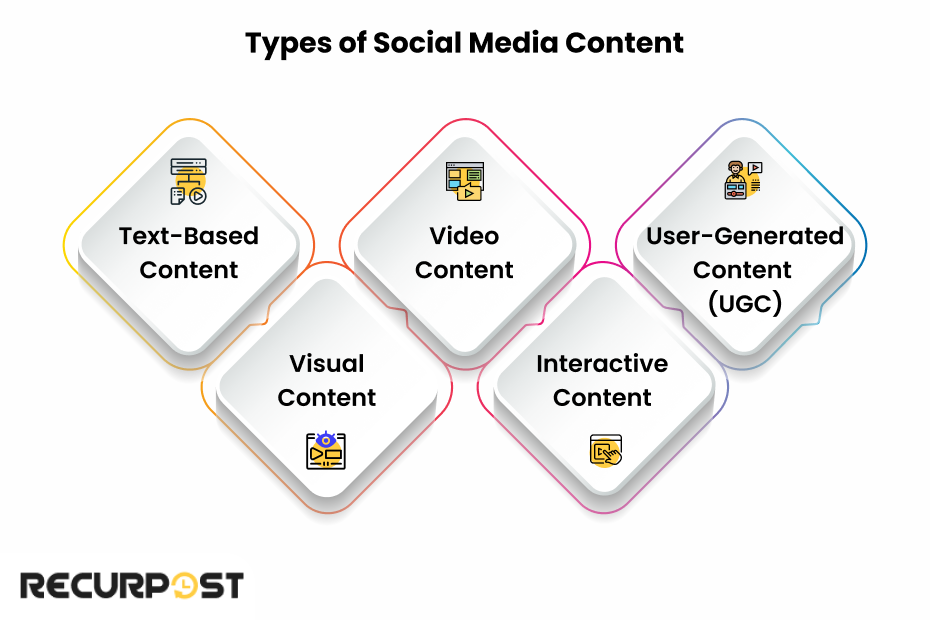
Social media content includes a wide range of post formats, such as:
1. Text-Based Content
While text may appear simple, it remains one of the most powerful forms of social media content. Short updates, microblogs, and captions share quick thoughts, spread updates, or collect feedback. Platforms like Twitter/X and LinkedIn articles thrive on text-heavy formats where short posts or threads encourage conversations.
Captions: Every image, reel, or video can be paired with a caption. Strong captions align with brand voice, include relevant hashtags, and use a clear call-to-action (CTA) to spark engagement.
Microblogs: On platforms like LinkedIn, microblogging can provide industry insights, tips, or personal stories that highlight your expertise.
2. Visual Content
Visuals grab attention instantly when scrolling through social media content feeds. On most social media platforms, visuals can take the form of:
High-quality images: Product shots, lifestyle photography, or event photos that highlight brand aesthetics.
Carousel posts and single-image posts: These could be structured visuals for tutorials, product features, or announcements.
Infographics: If you have complex data or want to explain a concept, an infographic can break it down visually, making it easier for your audience to absorb and share.
Memes and GIFs: Quick, funny, and relatable visuals that connect through humor or cultural relevance are great for sparking conversation or entertaining your audience. Social media posts based on memes often drive strong shares.
3. Video Content
Video content is one of the most impactful forms of social media content. It’s dynamic, visually stimulating, and often more shareable than static images.
Short-form video: Platforms like TikTok, Instagram Reels, and YouTube Shorts have made short-form video content a dominant force in social media content. These videos are quick, attention-grabbing, and perfect for viral moments.
Long-form video: Long-form video content thrives on platforms like YouTube, Facebook Live, LinkedIn, or IGTV that are great for live sessions. Whether you’re sharing tutorials, product reviews, or interviews, long-form content is a great way to add depth to your content strategy. This format is experiencing a long-form video resurgence, especially among niche communities and professional audiences.
Live streaming: Live streams and live sessions allow brands to interact in real time. Whether you’re hosting Q&As, product demos, or behind-the-scenes streams, live content offers a great way to connect with your audience instantly.
4. Interactive Content
Interactive social media content is the key to creating meaningful connections with your audience. People love being part of the conversation, which allows them to engage directly. Examples include:
Polls and surveys: Ask your audience for their opinions on products, share industry news, or even fun questions.
Quizzes: Quizzes are a fun and engaging way to entertain your target audience while gathering valuable insights about their preferences.
Contests and giveaways: People love free stuff, and rewarding participation can be a great way to boost engagement rate and expand your reach.
5. User-Generated Content (UGC)
User-generated content remains one of the most authentic forms of social media marketing. Not only does it act as social proof, but it also helps build trust. UGC could include:
Customer testimonials and reviews: Encourage customers to share their experiences with your product or service across social media platforms.
Reshared audience posts: If someone tags your brand or shares a post featuring your product, resharing it can add credibility and foster stronger connections with your audience.
Influencer collaborations: Partnerships with influencers or brand advocates are a great way to expand your reach and tap into new audiences.
What Makes a Perfect Social Media Post
Creating the perfect social media post isn’t about luck, but following a proven structure that captures attention and drives engagement. Successful social media content shares common elements that work together to deliver your message effectively.
The Anatomy of a Perfect Social Media Post
A perfect social media post combines several components that work together seamlessly:
Visual Hook: Your image or video should stop the scroll within the first 3 seconds. Whether it’s a striking photo, bold graphic, or engaging video thumbnail, visual consistency can help your visuals grab attention immediately.
Compelling Caption: Start with a hook that draws readers in, ask a question, share a surprising fact, or make a bold statement relevant to your audience’s interests. Strong captions paired with hashtags make social media content easier to discover.
Value-Driven Content: Every post should offer something valuable, whether it’s entertainment, inspiration, or educational insights. When the audience feels they gained something from your content, engagement rate and reach naturally improve.
Clear Call-to-Action (CTA): Tell your audience exactly what you want with specific and actionable CTA’s such as “double-tap if you agree,” “share your thoughts,” or “click the link in bio.” A clear CTA improves click-through rate and boosts conversions.
Hashtags: Mixing broad and niche hashtags increases visibility across social media platforms. A set of 5–10 targeted hashtags often performs better than overfilling.
Optimal Timing: Posting during peak engagement hours improves visibility. Optimal posting times often fall during lunch breaks or evenings, but exact times depend on your audience targeting and platform selection.
Platform-Specific Perfect Post Elements
Instagram Perfect Post: High-quality visuals + storytelling captions + relevant hashtags + Stories integration for maximum reach.
LinkedIn Perfect Post: Professional insights + industry relevance + thought leadership angle + networking-focused CTAs.
TikTok Perfect Post: Trending audio + quick hook in first 3 seconds + authentic personality + participation in current challenges.
Facebook Perfect Post: Community-focused content + longer-form storytelling + conversation starters + shareable value.
Why Social Media Content is Crucial for Your Success
Social media content is your primary tool for reaching and connecting with audiences across different social media platforms. Through your social media posts, you can foster community, educate your followers, and inspire them to take action. Consistent, high-quality social media content can help you:
Boost audience engagement by keeping your audience interested and interactive.
Increase brand awareness by showcasing your brand voice and values to your audience.
Drive conversions by providing value and inviting your audience to act through clear calls-to-action (CTAs).
Social media content plays a pivotal role in any digital marketing strategy. It’s not just about posting, but sparking conversations, reflecting audience preferences, and delivering valuable content that resonates with customer needs.
In 2024, the global digital content creation market was valued at approximately $30.6 billion and is projected to grow to $34.5 billion by 2025. [Source: Scoop Market US]
How to Create Content for Social Media
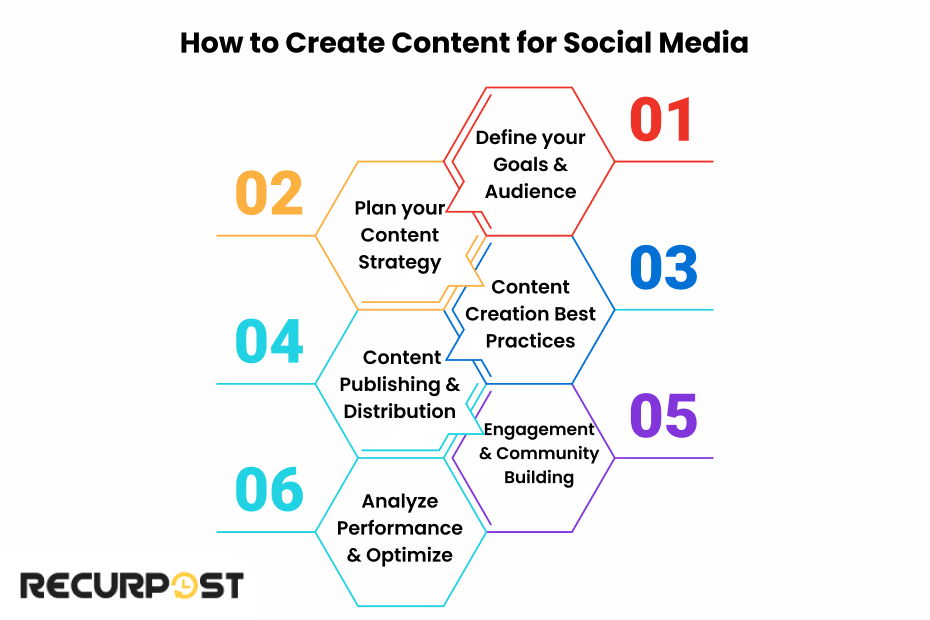
Step 1: Define Your Goals & Audience
Strong social media content requires a clear content strategy. You should:
Set SMART goals for your social media posts, such as boosting engagement rate or driving traffic to your website.
Identify your target audience by understanding their demographics, interests, and pain points.
Conduct social listening to gain insights into audience preferences, trending topics, and industry trends.
Step 2: Plan Your Content Strategy
Define goals and create a content calendar to balance your posting frequency and maintain consistency. Align your social media content with a timeline and a weekly plan:
Seasonal and latest trends, like a social media holiday, a topical day, or a product launch.
Your marketing campaigns to ensure your social media content complements other efforts.
Industry news or pop culture to stay up-to-date and relevant.
P.S.: Using RecurPost’s content calendar tool can help you stay organized across multiple social media platforms. It’s like having a spreadsheet to plan all your posts, with a sample to get you started, much like you would use a resume template.
Step 3: Content Creation Best Practices
Captions: Craft compelling captions that grab attention and follow the perfect post structure. Start with a hook, add valuable insights, and pair with a clear call-to-action (CTA).
Visual consistency: Use brand colors, fonts, and logos to ensure visual elements create an immediate stopping power and reflect your brand voice.
Strong CTAs: Write effective CTAs (Call-to-Actions) that guide people to engage, share, or visit your site with clear, actionable instructions.
Balanced structure: Structure your posts with the perfect formula: attention-grabbing visual + compelling opening line + valuable content + clear call-to-action + targeted hashtags.
Step 4: Content Publishing & Distribution
Optimize your social media content for various social media platforms (Instagram, Twitter/X, LinkedIn, etc.).
Post during optimal posting times for each platform when your audience is most active.
Repurpose content across different platforms to save time and expand your audience reach and impressions.
For this content scheduling, you can use a content repurposing tool!
Step 5: Engagement & Community Building
Encourage engagement by asking questions, running polls, and prompting discussions.
Respond to comments and messages to build a community around your brand.
Partner with influencers to help amplify your content and increase brand awareness.
Step 6: Analyze Performance & Optimize
Track key metrics like:
Engagement rates (likes, shares, comments)
Click-through rates (CTR)
Website traffic and conversions
Social Media Content Development: Categories & Formats
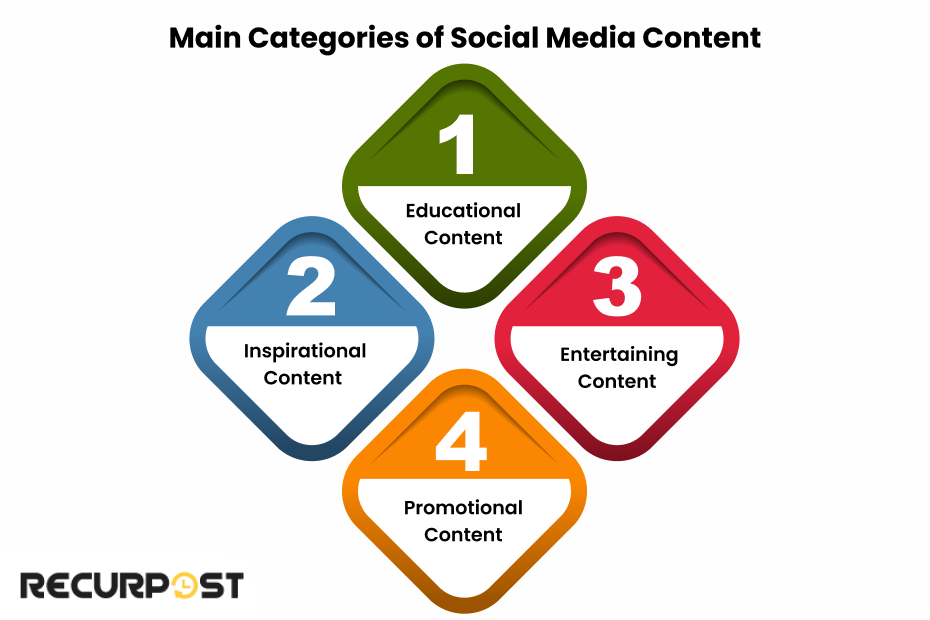
Main Categories of Social Media Content
To keep things fresh and interesting, rotate between different social media content categories. A balanced content mix ensures your audience sees variety while reinforcing consistent brand presence.
Let’s break down the 4 types of social media content you can use to connect with your followers and build your brand. Each type serves a different purpose, and using a mix of all four is key to keeping your social media content diverse and engaging.
1. Educational Content
Educational content helps your audience learn something new, positioning your brand as a valuable source of information. It builds trust and authority. Examples include:
How-to guides or tutorials (for a bakery on how to bake perfect bread, or for a life coach on how to set goals).
Industry news or insights
Expert Q&A sessions
2. Inspirational Content
Inspirational content motivates audiences while showcasing brand voice and values. It fosters an emotional connection and humanizes brands. Examples include:
Customer success stories (from a fitness brand showing a client’s journey or an insurance agency highlighting how they helped a family recover).
Motivational quotes
Brand mission or vision stories
3. Entertaining Content
Entertaining content keeps feeds lively and engaging. It gives audiences reasons to return and interact with posts. Examples include:
Memes and humor (studying the best meme marketing examples from companies like Gucci and Netflix can provide inspiration)
Behind-the-scenes footage
Viral challenges or trends
4. Promotional Content
Promotional content highlights your products or services and drives conversions with clear calls-to-action (CTAs). It encourages your audience to take action, whether that’s making a purchase or signing up. Examples include:
Product launches or feature highlights
Discounts and special offers
Customer testimonials
Different Content Formats for Social Media
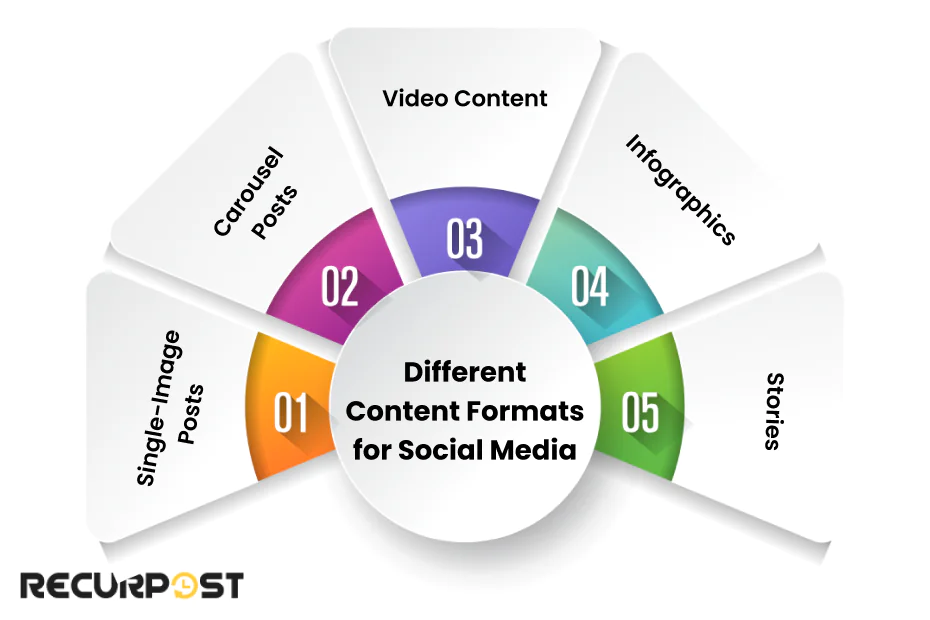
Now that we know the types of content, let’s look at the different social media content formats you can use to present your message on social media platforms.
1. Single-Image Posts
A simple image can say a lot. Whether it’s a product image or a motivational quote, single-image posts grab attention quickly and reinforce brand voice.
2. Carousel Posts
Carousel posts let you share multiple images or videos in one post. These are great for telling a story, showcasing several products, or breaking down a step-by-step guide.
3. Video Content
Video content ranks among the most powerful formats for social media content. From short-form video (like TikTok, Instagram Reels, YouTube Shorts) to long-form video (like YouTube tutorials, vlogs, reviews), videos are effective at capturing attention and boosting engagement.
4. Infographics
Infographics combine visuals with data, making information digestible while staying visually appealing. This format is perfect for explaining complex topics in a simple and comprehensible way.
5. Stories
Stories are perfect for real-time updates. Whether on Instagram or Facebook, stories give your audience a peek into what’s happening right now. They’re ideal for behind-the-scenes content, quick updates, or interactive polls.
If you are specifically looking to boost your social media engagement, read this blog post!
How to Create Engaging Content On Social Media Platforms
Each social media platform has unique social media content styles that drive audience engagement. Here’s what works best on the top platforms:
1. Instagram
- Utilize this friendly social platform and get a more engaged audience with the help of static posts, reels, and carousel images. They use engaging content like storytelling and trendy visuals to grab attention.
Increase engagement on Instagram with strategies on using Reels, Stories, and tools to schedule posts and grow interaction on your account.
2. TikTok
- Viral trends and challenges are the secret sauce here. Short, entertaining social media video trends get shared the most.
3. Facebook
- Some engaging Facebook posts, like live videos and group posts, spark meaningful conversations and keep people engaged for longer.
4. Twitter/X
- Timely tweets paired with images, GIFs, or polls are key to boosting engagement on this fast-paced platform.
Creating consistent social media content ideas can feel challenging, but several methods can keep creativity flowing:
Competitor analysis and trend tracking can provide insight into what’s working in your industry.
AI tools like RecurPost AI Content Generator can help spark content ideas.
User-generated content (UGC) campaigns can encourage your audience to share their perspectives, making posts more authentic and relatable.
Want the best marketing post ideas? Check out this blog: social media marketing post ideas.
How to Create Engaging Video Content
Video content is one of the most effective formats for social media content because:
It drives higher engagement rates compared to static content.
Short-form videos (such as Instagram Reels or TikTok) are easily shareable and often go viral.
Long-form videos (such as YouTube or IGTV) allow for deeper storytelling and brand exposure.
Tools & Resources for Social Media Content Development
Creating high-quality social media content consistently can be challenging, especially with the variety of content formats and the constantly changing nature of social media platforms. While some brands collaborate with meme marketing agencies for viral campaigns, others use in-house tools to streamline tasks.
Fortunately, there are many tools and resources to make this process smoother, more efficient, and much more effective. Whether you’re a business owner, a digital marketer, or a social media content creator, the right content creation tools can help you streamline your workflow, boost creativity, and track performance.
Here are some of the best tools and resources for creating compelling and engaging social media content.
- Scheduling tools: Hootsuite, Buffer, and RecurPost for managing posting times and maintaining a social media calendar.
- AI content generators: Tools that generate captions, hashtags, or content ideas quickly.
1. Graphic Design Tools
For designing stunning graphics for social media posts, you don’t need to be a professional designer. There are numerous user-friendly tools available, allowing you to create visuals that can communicate your brand values and elevate your social media presence.
Canva
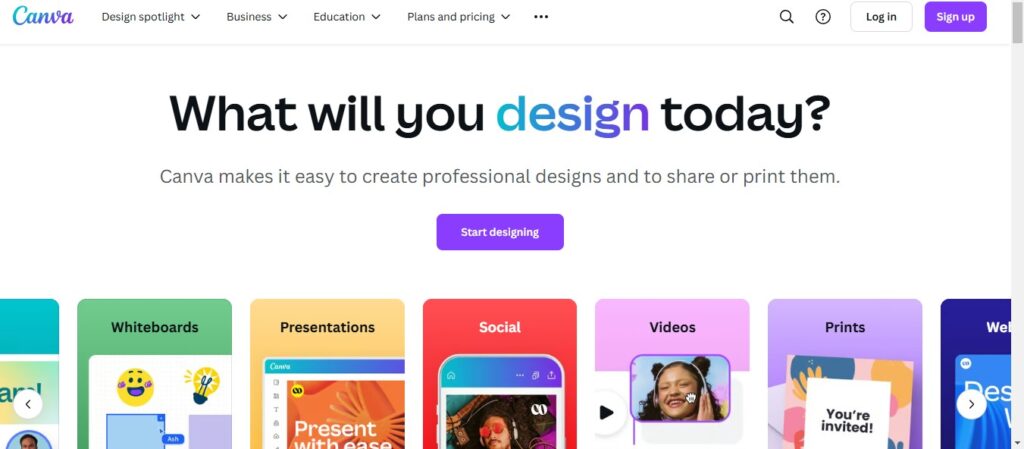
One of the most popular graphic design tools, Canva, simplifies the creation of social media content. Whether you’re crafting Instagram posts, Pinterest Pins, Facebook covers, or even Instagram stories, Canva has hundreds of templates that make design accessible to everyone. Its drag-and-drop interface allows you to easily test different layouts, colors, and fonts of your social media content.
Tip: Canva Pro unlocks advanced features like background remover, premium templates, and a brand kit for maintaining visual consistency across social media platforms.
Adobe Spark
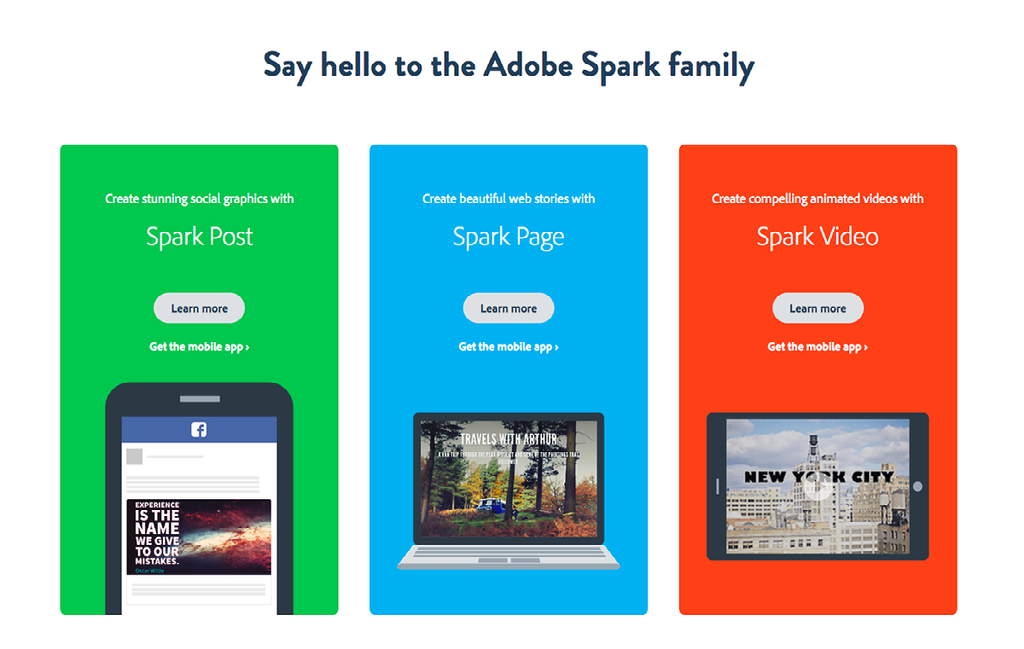
For those preferring more robust content creation tools, Adobe Spark is another excellent option, perfect for creating both static visuals and animated designs. It also offers templates optimized for social media content. If you’re looking to quickly create branded videos, Adobe Spark makes it super easy with its video editing and text animation tools.
Tip: Adobe Spark integrates well with other Adobe social media tools, such as Adobe Photoshop, making it ideal if you’re already invested in the Adobe ecosystem.
VistaCreate (formerly Crello)

VistaCreate is another design tool worth considering for your social media content. It boasts a large collection of templates specifically designed for social media channels like Instagram, Facebook, LinkedIn, and more. Despite being known for its simple user interface, its extensive library of animations, stickers, and stock photos offers flexibility for creative campaigns.
Tip: VistaCreate also offers a resizing feature that makes content repurposing simple, helping brands adapt designs for different social media platforms without starting from scratch.
2. Video Editing Tools
Video content is one of the most interactive formats for social media content. Creating high-quality videos doesn’t have to require expensive software or professional equipment. Here are a few great tools to help you edit and optimize video content for various social media platforms.
iMovie
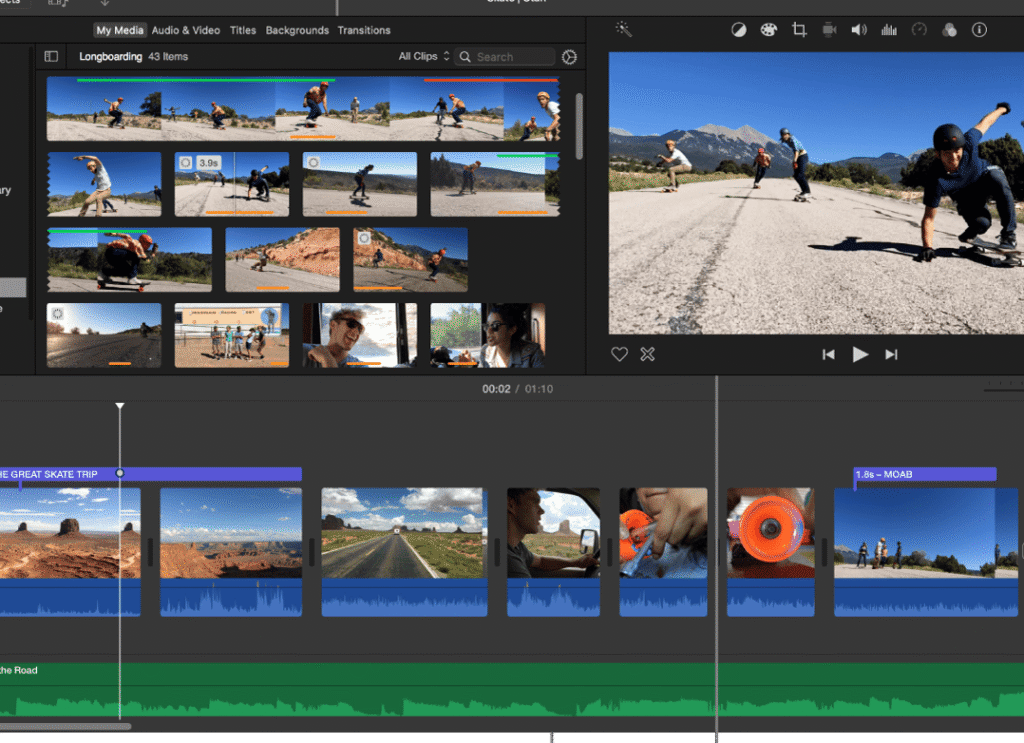
For Apple device users, iMovie is an incredibly user-friendly video content editing tool for creating professional videos without a steep learning curve. Whether you’re making short-form video content for Instagram and TikTok or long-form video for YouTube, iMovie offers everything from basic cutting tools to transitions, special effects, and music tracks. If you are just getting started with video content creation, it’s a solid option for you.
Tip: iMovie has templates that help you produce polished content videos in less time, so if you’re on a tight schedule, take advantage of this feature.
CapCut
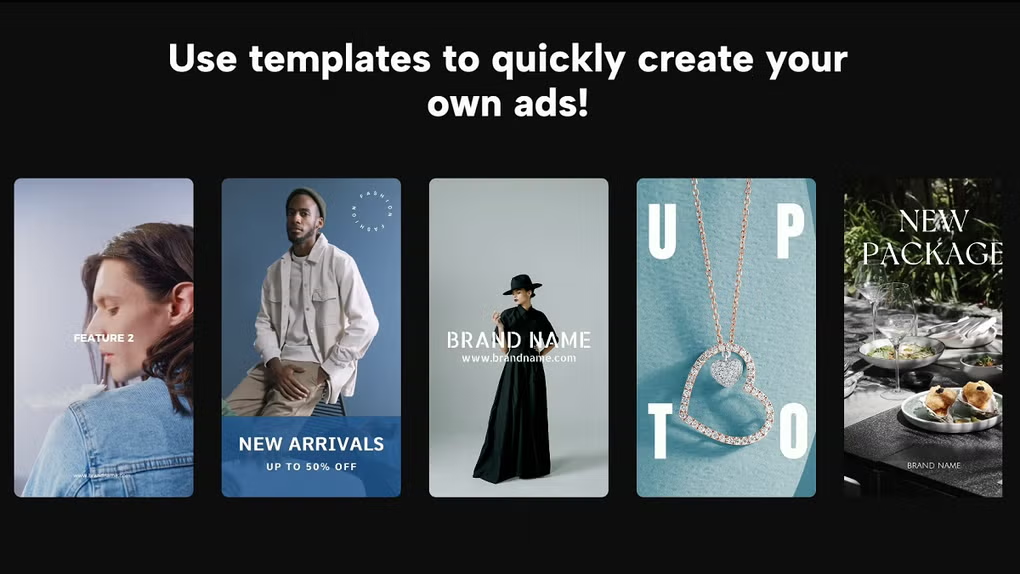
If you’re looking to create short-form videos from your mobile device, especially for platforms like TikTok or Instagram Reels, CapCut is an excellent mobile video editor. It’s free and offers powerful editing features, like cutting, trimming, adding music, and even applying special effects or filters to your video content. You can also create text animations and overlays to keep your audience engaged throughout the video.
Tip: CapCut’s ease of use and accessibility make it ideal for digital content creators who need to produce quick videos that keep their audience engaged across social media channels.
Adobe Premiere Rush
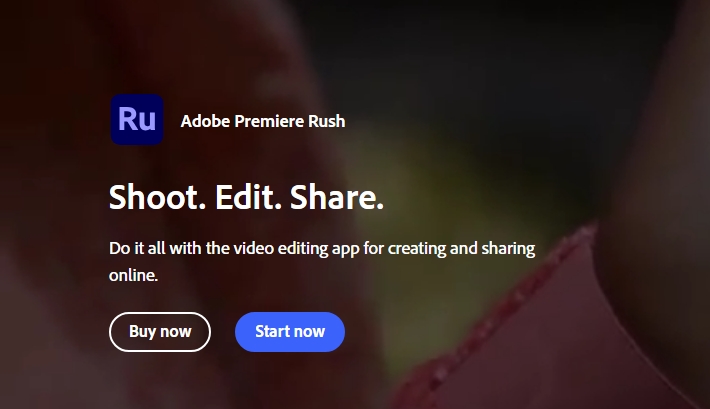
Adobe Premiere Rush provides various media content editing features such as color correction, audio adjustments, transitions, and titles, while remaining simpler than Adobe Premiere Pro. It works well for both short and long-form social media content and is great for creators who want to level up their video content but don’t want to deal with the complexity of more advanced software.
Tip: Adobe Premiere Rush also offers cloud sync, allowing you to edit your videos on multiple devices, which is great for creators on the go.
3. Content Scheduling & Management
Creating social media content is only part of the puzzle. To maintain consistency, content scheduling tools that help you plan, schedule, and publish posts across multiple social media platforms are essential. These tools save time while helping teams deliver content at optimal posting times.
RecurPost
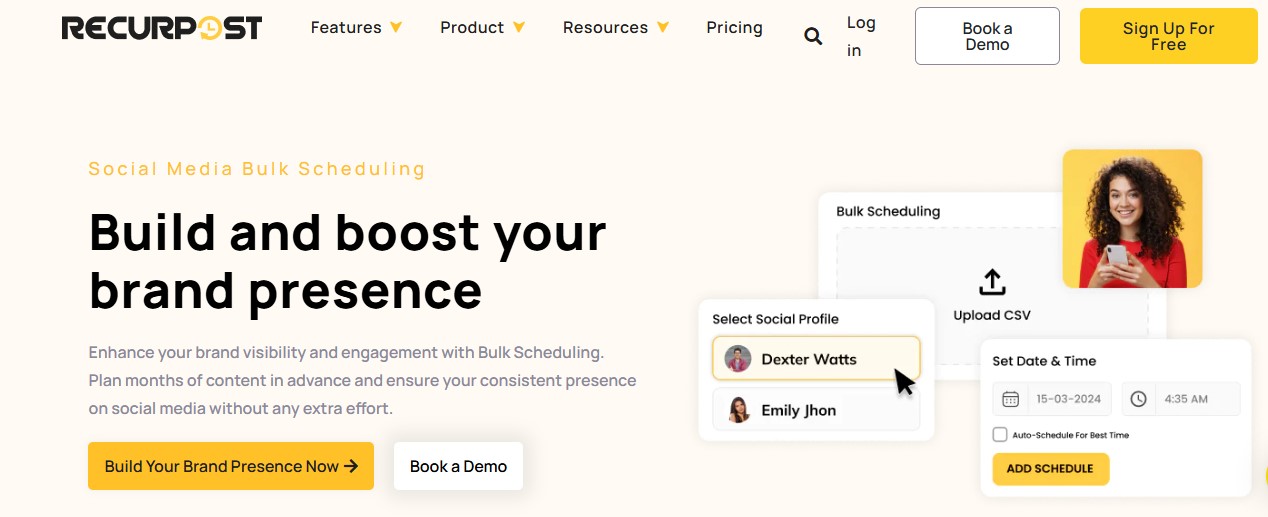
If you’re looking for a tool specializing in content repurposing, RecurPost is a great choice. It helps you not only in scheduling your posts, but also in automatically recycling evergreen content and posting it again at optimal times. This tool is especially useful for social media managers needing to maintain a steady stream of content without reinventing the wheel each time.
Tip: RecurPost’s AI social media content generator can help you come up with new social media post ideas and generate content for your social media channels.
To know more about this tool, check out RecurPost’s AI Content Generator.
Hootsuite
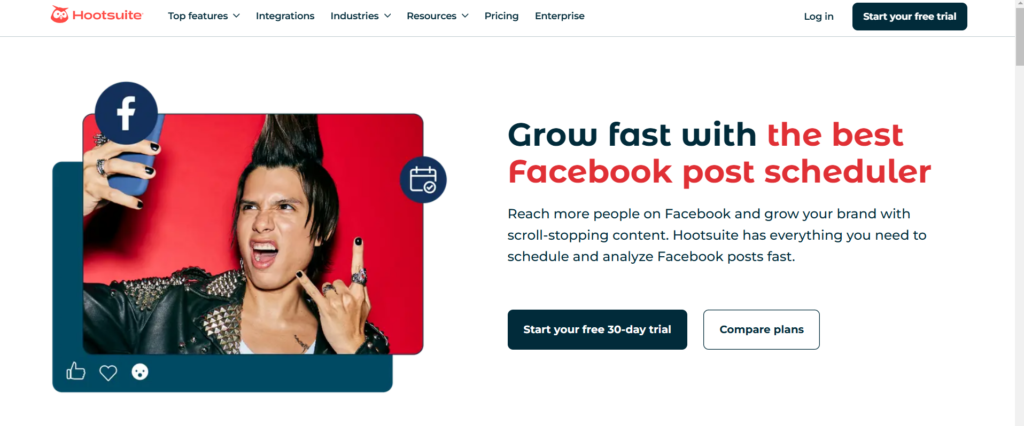
Hootsuite is a widely recognized scheduling tool supporting platforms like Twitter/X, LinkedIn, Instagram, and Facebook. Its single dashboard makes it easier to manage posts across channels. Hootsuite also includes detailed analytics tools to measure the performance of your social media content.
Tip: Hootsuite’s AutoSchedule feature can automatically choose the best times to post based on your audience’s activity.
Buffer
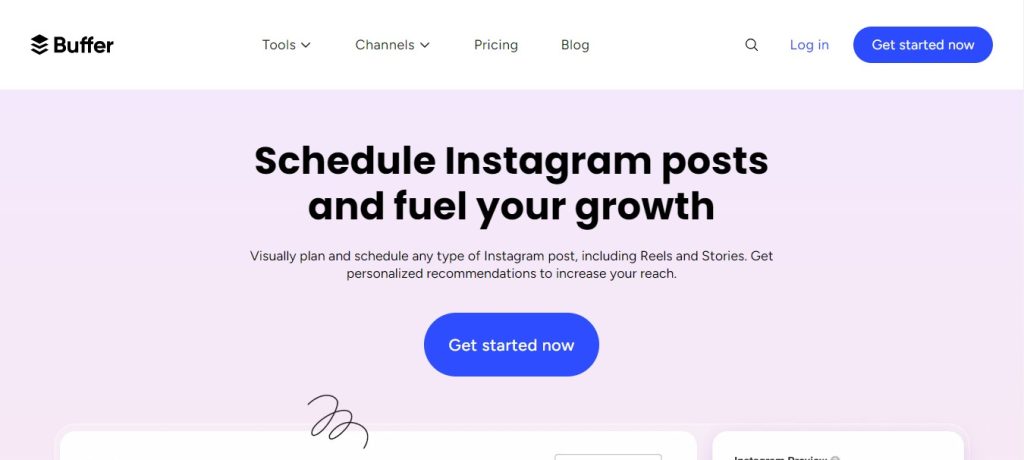
Buffer is another popular tool designed for scheduling, analyzing, and managing social media content. It allows you to plan posts in advance and offers a simple interface, making it easy to schedule posts for Facebook, Instagram, Twitter/X, and LinkedIn. One of Buffer’s standout features is its detailed analytics section, where you can track your post’s engagement metrics, clicks, and conversions.
Tip: Buffer also offers a feature called Pablo, which lets you quickly create social media content and images tailored to specific social media platforms.
Conclusion
Creating social media content is a strategic process requiring a social media planner, creativity, and consistent engagement with your audience. By understanding your audience, setting clear goals, and using the right content creation tools, you can create content that builds brand awareness, drives traffic, and fosters a loyal community across multiple social media channels.
Start implementing these strategies today, and you’ll soon be well on your way to dominating social media platforms with high-quality, engaging content.
Frequently Asked Questions
1. What are the main types of social media content?
The four main types of social media content are educational content, inspirational content, entertaining content, and promotional content.
2. How can I generate fresh content ideas?
You can generate new content ideas by analyzing industry trends, performing competitor research, engaging in social listening, and utilizing AI content generators for inspiration.
3. What tools can help with content creation?
Tools like Canva, CapCut, Hootsuite, Buffer, and RecurPost can help streamline your content creation and scheduling.
4. How do I measure the success of my content?
Track key performance indicators (KPIs) such as engagement rates, reach, impressions, click-through rates, website traffic, and conversions to measure the success of your content.
5. How do I create video content for social media?
Start by planning your content, keeping your videos short, engaging, and platform-optimized. Add subtitles for accessibility, include a hook in the first few seconds, and always have a clear call-to-action (CTA).
6. What are some tips for creating effective captions?
Craft captions that are compelling and align with your brand voice. Use concise language, incorporate relevant keywords, and end with a call to action to prompt audience engagement.
7. How can I improve my audience engagement?
To increase engagement, post regularly, encourage interaction with valuable content like polls and questions, run contests, and actively respond to comments and messages.

Ayushi Jain is a content writer with expertise in creating engaging, SEO-friendly content across various industries. With a focus on storytelling and clarity, she helps brands connect with their audience effectively.

